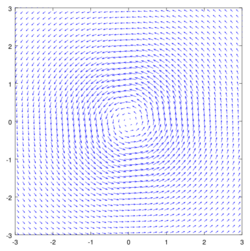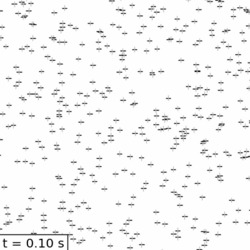Lamb–Oseen vortex
In fluid dynamics, the Lamb–Oseen vortex models a line vortex that decays due to viscosity. This vortex is named after Horace Lamb and Carl Wilhelm Oseen.[1][2]


Mathematical description
Oseen looked for a solution for the Navier–Stokes equations in cylindrical coordinates with velocity components of the form
where is the circulation of the vortex core. Navier-Stokes equations lead to
which, subject to the conditions that it is regular at and becomes unity as , leads to[3]
where is the kinematic viscosity of the fluid. At , we have a potential vortex with concentrated vorticity at the axis; and this vorticity diffuses away as time passes.
The only non-zero vorticity component is in the direction, given by
The pressure field simply ensures the vortex rotates in the circumferential direction, providing the centripetal force
where ρ is the constant density[4]
Generalized Oseen vortex
The generalized Oseen vortex may be obtained by looking for solutions of the form
that leads to the equation
Self-similar solution exists for the coordinate , provided , where is a constant, in which case . The solution for may be written according to Rott (1958)[5] as
where is an arbitrary constant. For , the classical Lamb–Oseen vortex is recovered. The case corresponds to the axisymmetric stagnation point flow, where is a constant. When , , a Burgers vortex is a obtained. For arbitrary , the solution becomes , where is an arbitrary constant. As , Burgers vortex is recovered.
See also
- The Rankine vortex and Kaufmann (Scully) vortex are common simplified approximations for a viscous vortex.
References
- ↑ Oseen, C. W. (1912). Uber die Wirbelbewegung in einer reibenden Flussigkeit. Ark. Mat. Astro. Fys., 7, 14–26.
- ↑ Saffman, P. G.; Ablowitz, Mark J.; J. Hinch, E.; Ockendon, J. R.; Olver, Peter J. (1992). Vortex dynamics. Cambridge: Cambridge University Press. ISBN 0-521-47739-5. p. 253.
- ↑ Drazin, P. G., & Riley, N. (2006). The Navier–Stokes equations: a classification of flows and exact solutions (No. 334). Cambridge University Press.
- ↑ G.K. Batchelor (1967). An Introduction to Fluid Dynamics. Cambridge University Press.
- ↑ Rott, N. (1958). On the viscous core of a line vortex. Zeitschrift für angewandte Mathematik und Physik ZAMP, 9(5-6), 543–553.
 |

